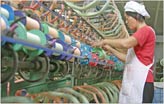Web Comments
Political dogma limits US economic recovery
Updated: 2011-06-13 09:20
By John Ross (chinadaily.com.cn)
Consequently it took the US three years, 4th quarter 2007 to 4th quarter 2010, for its GDP to regain pre-crisis levels. In the same period, China's economy expanded by 30 percent.
Claims that the financial crisis showed the superiority of China's economic structure were therefore not mere rhetoric. China's "socialist market economy" proved more capable of dealing with the financial crisis than the US' "free market economy."
Naturally there are US economists who understand the deadly flaw in the US economy of the lack of any automatic mechanism to turn finance into investment. Krugman has pointed to crumbling US infrastructure. Richard Duncan calls for "a national industrial-restructuring program in which the government would invest in 21st Century technologies with the goal of establishing an unassailable American lead in the industries of the future."
But even the most minimal of such programs cannot be delivered given US economic structure. Large-scale government intervention in investment would alter the balance between the state and private sectors in the US, increasing the former's weight. This would require a sharp shift in the structure of the US economy and would be strongly resisted on ideological grounds.
Keynes, who diagnosed the problem, naturally knew how to deal with liquidity traps. While he opposed the state administering the economy, the Soviet system that China followed before 1978, Keynes said the state would have to intervene to set the overall level of investment - "the duty of ordering the current volume of investment cannot safely be left in private hands." Keynes said that low interest rates policies alone, of the type currently pursued by the US Federal Reserve, would not overcome the liquidity trap: "It seems unlikely that the influence of banking policy on the rate of interest will be sufficient by itself to determine an optimum rate of investment. I conceive, therefore, that a somewhat comprehensive socialization of investment will prove the only means of securing an approximation to full employment."
The system described by Keynes for dealing with liquidity strikingly resembles China's present economic structure. While Keynes believed that a "somewhat comprehensive socialization of investment" was necessary, with the state determining "the current volume of investment," he said: "This need not exclude all manner of compromises and devices by which public authority will co-operate with private initiative."
As in China's present system, Keynes therefore saw the state and the private sector as two elements of the same system - not, as in current US ideology, that the state and the private sector are counterposed.
The test of these two contrasting approaches in the present international economic situation has been decisive and clear. The US economy has been weak in its recovery and has been slowing further. China's economy has expanded by almost a third. US political dogmas are limiting its economic recovery.
John Ross is Visiting Professor at Antai College of Economics and Management, Shanghai Jiao Tong University. From 2000 to 2008, he was then London mayor Ken Livingstone's Policy Director of Economic and Business Policy.
E-paper

Pearl on the Yangtze
Wuxi is considered a town of natural beauty and its motto is "city of water and warmth".
Prose and consternation
Riding on a mystery train
Way of a warrior
Specials

Wealth of difference
Rich coastal areas offer contrasting ways of dealing with country's development

Seal of approval
The dying tradition of seal engraving has now become a UNIVERSITY major

Making perfect horse sense
Riding horses to work may be the clean, green answer to frustrated car owners in traffic-trapped cities
